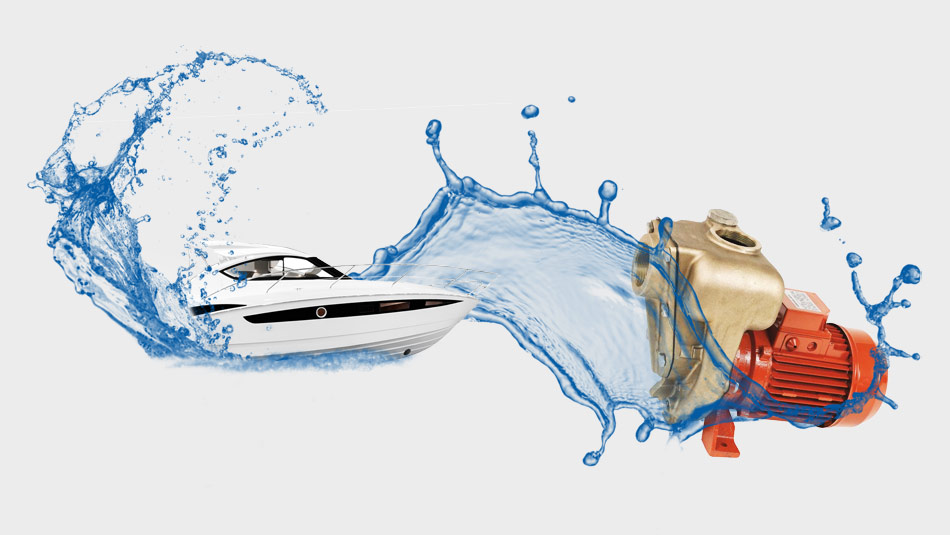Why is a freshwater pump essential aboard a boat?

Everything you need to know about fresh water pumps, essential for a boat
It is essential to have access to fresh water aboard a boat. It ensures the vessel's water supply. To pump the water, it is necessary to install a specific hydraulic pump. However, the pumping system on a boat can also serve other purposes. Discover the different water pumps for boats and the criteria to choose the model you need.
Need advice?
Our team of experts is here to help you.
You can contact us via a simple click:
What are the uses of water pumps for boats?
Hydraulic boat pumps can be distinguished according to their use. It is thus possible to install several pumps on a boat.
The booster pump
This is a pressurised tank that ensures the supply of fresh water on board. It is fed by a booster pump.
The booster unit supplies the shower, toilets and also the tap in the kitchen area. Indeed, it can stock sanitary water in an ACS tank (drinking water standard).
In terms of installation, the boosters are connected by a hose to the drinking water tank and installed inside the vessel. They consist of a bladder tank and a surface pump that increase the water pressure. Thanks to a pressure switch, this electric pump only triggers when you draw water. Its principle is to operate under constant pressure in order to maintain a constant water flow rate.
The emergency manual pump
This is an important piece of safety equipment aboard a boat. In case of a power supply failure, it enables the priming of the boat's motor. This type of manual pump is thus used for emergency pumping.
This system stands out for its sturdiness, ease of use and rapidity. You simply activate the pump in case of a power failure to start the motor.
Manual bilge pumps
If the boat does not have a draining system, these siphon or portable pumps provide an effective solution for the discharge and evacuation of water as well as for deck cleaning.
As they provide a low flow rate, between 25 and 100 litres per minute, they are more frequently installed on small boats or as a complement to an electric pump. There are also fixed diaphragm pumps.
Electric bilge pumps
These are immersion pumps. Perfectly watertight, they operate with a small electrical power supply. A little like a cellar pump, they pump the water in the lower or less accessible parts of the boat. They are equipped with a starting switch. The pumped water is directly evacuated to the sea.
There are also automatic pumps equipped with a floater. The advantage of this system is that when it detects a critical water level, it automatically starts pumping.
Turbine pumps
These water pumps are installed for both inboard and outboard boat engines. Equipped with vanes, they suck in water and propel it into the engine to enable cooling to avoid damage due to engine overheating. Turbine pumps, which reach a high flow rate, are also installed for the suction and transfer of a storage tank, deck washing and, more rarely, can be used in case of fire.
To resist the abrasion and wear caused by salt water, an immersion pump must be carefully chosen and regularly serviced. Pompes Japy proposes a full range of electric pumps: JET02BZ / JET10BZ / JET14BZ, for single-phase 230 Volt motors, and the JET03BZ / JET11BZ / JET15BZ series for larger, three-phase 400 Volt motors. Consisting of a bronze pump body, these systems are suitable for dual use with fresh water and seawater.
Pulley pumps
These pumping systems do not have a built-in electric motor. Pulley pumps are operated by the boat's engine. They are installed in boats that do not have an electric generator, like certain sailing boats and fishing boats.
What factors should you consider when choosing a manual boat pump?
The choice of a manual boat pump first depends on the boat's sailing area. In a saline atmosphere, it is necessary to choose materials that perfectly resist corrosion. The installation of a bronze pump is recommended.
Pompes Japy bronze hand pumps are standardised and referenced by the French navy. These multi-purpose pumps have the advantage of being able to pump different liquids: seawater, water containing particles, fresh water, diesel fuel, etc.
It is also necessary to correctly size your project:
- The pumping capacity or pump power in Watts;
- The pressure in bars;
- The flow rate in litres per hour.
The choice depends on the type of boat and your needs.
Lastly, the model of pump depends on the use you intend to make of it: a booster pump to draw on a reserve of domestic water, a drainage pump to empty the bilge, a pumping station for the evacuation of water containing particles, etc.
To obtain personalised advice and ensure that you choose the most suitable model for your boat, contact us by telephone on +33 (0)3 81 96 16 47 or via our contact form.
